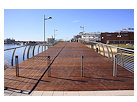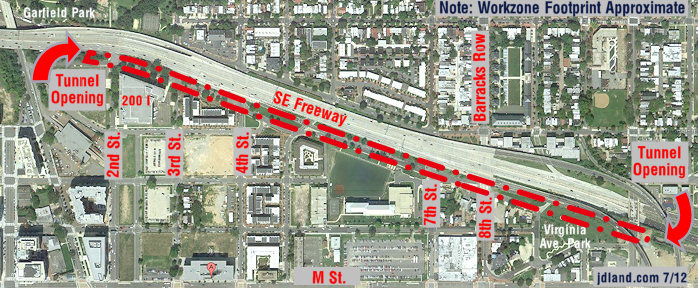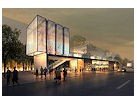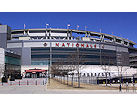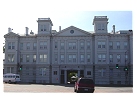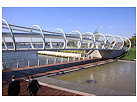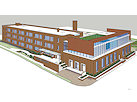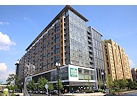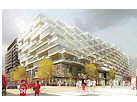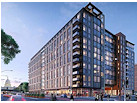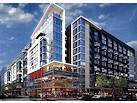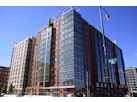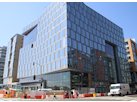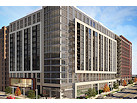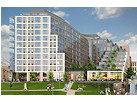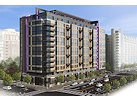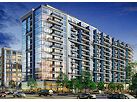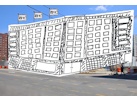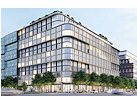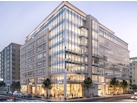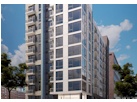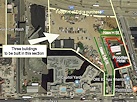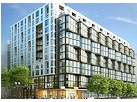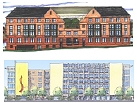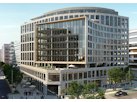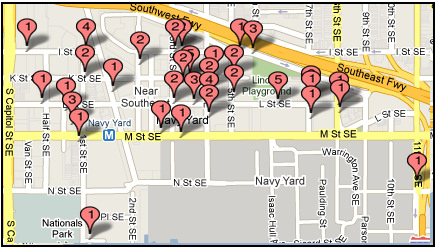|
| ||||||||||||||||||||
Please note that JDLand is no longer being updated.
peek >>
Near Southeast DC Past News Items: Rearview Mirror
- Full Neighborhood Development MapThere's a lot more than just the projects listed here. See the complete map of completed, underway, and proposed projects all across the neighborhood.
- What's New This YearA quick look at what's arrived or been announced since the end of the 2018 baseball season.
- Food Options, Now and Coming SoonThere's now plenty of food options in the neighborhood. Click to see what's here, and what's coming.
- Anacostia RiverwalkA bridge between Teague and Yards Parks is part of the planned 20-mile Anacostia Riverwalk multi-use trail along the east and west banks of the Anacostia River.
- Virginia Ave. Tunnel ExpansionConstruction underway in 2015 to expand the 106-year-old tunnel to allow for a second track and double-height cars. Expected completion 2018.
- Rail and Bus Times
Get real time data for the Navy Yard subway, Circulator, Bikeshare, and bus lines, plus additional transit information. - Rail and Bus Times
Get real time data for the Navy Yard subway, Circulator, Bikeshare, and bus lines, plus additional transit information. - Canal ParkThree-block park on the site of the old Washington Canal. Construction begun in spring 2011, opened Nov. 16, 2012.
- Nationals Park21-acre site, 41,000-seat ballpark, construction begun May 2006, Opening Day March 30, 2008.
- Washington Navy YardHeadquarters of the Naval District Washington, established in 1799.
- Yards Park5.5-acre park on the banks of the Anacostia. First phase completed September 2010.
- Van Ness Elementary SchoolDC Public School, closed in 2006, but reopening in stages beginning in 2015.
- Agora/Whole Foods336-unit apartment building at 800 New Jersey Ave., SE. Construction begun June 2014, move-ins underway early 2018. Whole Foods expected to open in late 2018.
- New Douglass BridgeConstruction underway in early 2018 on the replacement for the current South Capitol Street Bridge. Completion expected in 2021.
- 1221 Van290-unit residential building with 26,000 sf retail. Underway late 2015, completed early 2018.
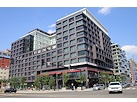
- NAB HQ/AvidianNew headquarters for National Association of Broadcasters, along with a 163-unit condo building. Construction underway early 2017.
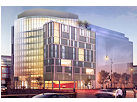
- Yards/Parcel O Residential ProjectsThe Bower, a 138-unit condo building by PN Hoffman, and The Guild, a 190-unit rental building by Forest City on the southeast corner of 4th and Tingey. Underway fall 2016, delivery 2018.
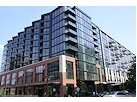
- New DC Water HQA wrap-around six-story addition to the existing O Street Pumping Station. Construction underway in 2016, with completion in 2018.
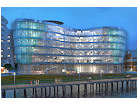
- The Harlow/Square 769N AptsMixed-income rental building with 176 units, including 36 public housing units. Underway early 2017, delivery 2019.
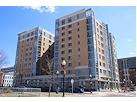
- West Half Residential420-unit project with 65,000 sf retail. Construction underway spring 2017.
- Novel South Capitol/2 I St.530ish-unit apartment building in two phases, on old McDonald's site. Construction underway early 2017, completed summer 2019.
- 1250 Half/Envy310 rental units at 1250, 123 condos at Envy, 60,000 square feet of retail. Underway spring 2017.
- Parc Riverside Phase II314ish-unit residential building at 1010 Half St., SE, by Toll Bros. Construction underway summer 2017.
- 99 M StreetA 224,000-square-foot office building by Skanska for the corner of 1st and M. Underway fall 2015, substantially complete summer 2018. Circa and an unnamed sibling restaurant announced tenants.
- The Garrett375-unit rental building at 2nd and I with 13,000 sq ft retail. Construction underway late fall 2017.
- Yards/The Estate Apts. and Thompson Hotel270-unit rental building and 227-room Thompson Hotel, with 20,000 sq ft retail total. Construction underway fall 2017.
- Meridian on First275-unit residential building, by Paradigm. Construction underway early 2018.
- The Maren/71 Potomac264-unit residential building with 12,500 sq ft retail, underway spring 2018. Phase 2 of RiverFront on the Anacostia development.
- DC Crossing/Square 696Block bought in 2016 by Tishman Speyer, with plans for 800 apartment units and 44,000 square feet of retail in two phases. Digging underway April 2018.
- One Hill South Phase 2300ish-unit unnamed sibling building at South Capitol and I. Work underway summer 2018.
- New DDOT HQ/250 MNew headquarters for the District Department of Transportation. Underway early 2019.
- 37 L Street Condos11-story, 74-unit condo building west of Half St. Underway early 2019.
- CSX East Residential/Hotel225ish-unit AC Marriott and two residential buildings planned. Digging underway late summer 2019.
- 1000 South Capitol Residential224-unit apartment building by Lerner. Underway fall 2019.
- Capper Seniors 2.0Reconstruction of the 160-unit building for low-income seniors that was destroyed by fire in 2018.
- Chemonics HQNew 285,000-sq-ft office building with 14,000 sq ft of retail. Expected delivery 2021.
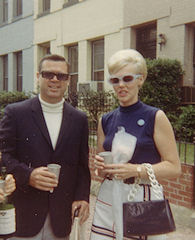 As I've always tried to emphasize when I'm asked about the origins of JDLand, I'm a historian at heart--I love knowing about how areas I'm familiar with looked and functioned in the past, especially the more recent past, when you can still see of few of the strings tying that era to the present day.
As I've always tried to emphasize when I'm asked about the origins of JDLand, I'm a historian at heart--I love knowing about how areas I'm familiar with looked and functioned in the past, especially the more recent past, when you can still see of few of the strings tying that era to the present day. This is very much the case for me for Capitol Hill, land of my birth, and I'm lucky enough to have two very good resources to turn to whenever I want to hear some good stories about what my neighborhood was like back in the Mad Men era: my mother and father. Jim and Shirley each moved to DC in 1959, got married a few years later, and lived on the House side of the Hill until 1969, and it's no secret that they look back upon those years with great fondness.
Since I'm all about documenting stuff before it disappears, I recently asked Mom and Dad if they would write up for me their memories of what it was like to live on the Hill during the 1960s. Luckily it's the offseason for both bicycling (Dad) and golf (Mom), so they agreed to squeeze some writing into their schedules, and while the resulting reminiscences are mostly for the family's benefit and enjoyment, I thought that some readers might find them of interest as well, and since the web site has infinite space, and since it's wintertime, when news is slow...
First up is a short post by my dad, talking a little about when he moved to the Hill in 1959, living in the 400 block of New Jersey Ave., SE., with his brother, for $100 a month. (I also tossed in at the bottom some of the home movies showing Hill scenes, most of which I've linked to before, but I figure some multimedia can't hurt.)
If you have questions for Dad about his post or just want to pick his brain for other memories of his, post here in the comments, and I'll make sure he reads them and replies. He's already working on his next offering, so maybe some queries from the peanut gallery will rattle loose some additional nuggets to pass along.
(And hopefully before too long I'll get a submission from Mom, so that she can tell the stories of shopping at Weisfeld's when it was still in the 100 block of E and how Mrs. Weisfeld would just write what you owed on the back of a brown paper bag, and then give you a bill at the end of the month. But I don't want to steal her thunder.)
UPDATE: Like his daughter, Dad has discovered that writing about something interesting can take on a life of its own--he's submitted his second post about the Hill in the early '60s, with tidbits on the Kennedy inauguration (and its accompanying snowstorm) and the construction of the Rayburn House Office Building, along with a few famous names, memories of biking around the Hill, and even a little bit about Southwest. I'll post it in a couple of days.
|
Comments (0)
More posts:
Rearview Mirror
|
Here's a bunch of little items that aren't ridiculously newsworthy, but that might be of interest. Since it's Friday and many of you actually have lives, I suggest reading a few at a time, and keep coming back over the weekend until you get through all of them. Some I've already passed along via Twitter (which you can also follow by being a Facebook Fan of JDLand), but some are surprisingly fresh. Here goes:
Top items:
* The process that will beget the new Southwest Waterfront is now underway, and SWill at Southwest: The Fabulous Blog With the Funny Name (did I get that right?) reports on this week's public meeting by the developers. Current plans call for 560 residential units, three hotels totalling 600 rooms, 840,000 square feet of office, 335,000 square feet of ground floor retail, some sort of music hall / museum / maritime education offering, 2,500 underground parking spaces in five garages, and 400-500 marina slips, with 60 percent of the site area being public space.
* Back before 1015 Half Street was a slow-to-finish office building, it was an old industrial building that in 1995 became the Capitol Ballroom and then eventually the Nation nightclub. But from its construction in 1931 until it was sold at auction in 1992, the southwest corner of Half and K was home to the J.E. Hurley Machine and Boiler Works company. And thanks to the Kinorama Flickr stream that took the Twitterverse by storm this week, here's a shot of the Hurley building, undated but probably in the early 1990s. The outlines of the more-familiar Nation building are clearly visible.
* Pastor Mark Batterson, writing about the National Community Church's purchase of the Miles Glass site at 8th and Virginia, says that they are looking at some of the adjacent properties as well. "Our current lot serves our current purposes, but when we think in twenty year terms the additional lots would give us more upside potential."
Calendar items:
* On Friday, Oct. 8, the Susan G. Komen 3-Day Race for the Cure will be holding its opening ceremonies at Nationals Park. It's not just for participants, and friends and family are also being encouraged to attend. Walkers will start arriving around 6 am, with the opening ceremony beginning (with "community stretching" at 7 am). Afterward, the participants will begin their 60-mile walk (though I can't find a map to figure out their route). More information about the opening ceremonies and race here.
* Mayor-in-Effect Vince Gray is having a series of town halls during October, with the Ward 6 one scheduled for Oct. 27 at 8:30 pm at Eastern High School, 1700 East Capitol St. NE.
Tidbits:
* Because I'm worried that the Marines' hunt for a new barracks site isn't engendering enough conversation around here, I'll point people to Norm Metzger's report on last week's Community Leadership Group meeting that I wrote about here.
* The Examiner did a Three-Minute Interview with Sam Fromartz of the Virginia Avenue Park's community garden.
* It's time once again for the Capitol Riverfront Perception Survey. Tell 'em what you perceive.
Off-Topic:
* I've written a few times about my interest in Detroit, and whether it can come back from so far down. If you haven't been following along, here's a great essay with lots of photos, written by David Byrne. (Yes, that David Byrne.) (thanks to reader EH)
* And, for the ultimate Friday time-waster, here's my bottlecap chasing cat that thinks he's a dog.
|
Comments (0)
More posts:
1015 Half, Barracks, Nat'l Community Church, Rearview Mirror, square 697, Stadium Events
|
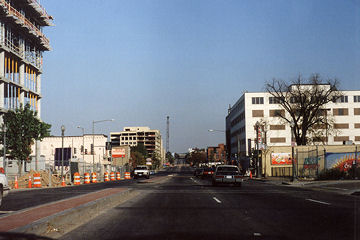 While I officially date the start of my blogging about Near Southeast as being January 2003, that was not when I took my first photos around the neighborhood. In the early fall of 2000, I grabbed a camera (a FILM camera!) and drove south of the freeway, around the neighborhood whose name I didn't know, to take some pictures. I had no plan to do anything with them; in fact, the prints quickly got filed away and I didn't even remember having them until I stumbled across them in 2004. The film I used was bad, so many of the shots barely came out. I don't even know exactly what day it was--judging by the color of the trees, it could be late September or early October. But, despite all of that, the 24 photos I took, now 10 years ago, mark the beginning of my very strange and unexpected odyssey.
While I officially date the start of my blogging about Near Southeast as being January 2003, that was not when I took my first photos around the neighborhood. In the early fall of 2000, I grabbed a camera (a FILM camera!) and drove south of the freeway, around the neighborhood whose name I didn't know, to take some pictures. I had no plan to do anything with them; in fact, the prints quickly got filed away and I didn't even remember having them until I stumbled across them in 2004. The film I used was bad, so many of the shots barely came out. I don't even know exactly what day it was--judging by the color of the trees, it could be late September or early October. But, despite all of that, the 24 photos I took, now 10 years ago, mark the beginning of my very strange and unexpected odyssey.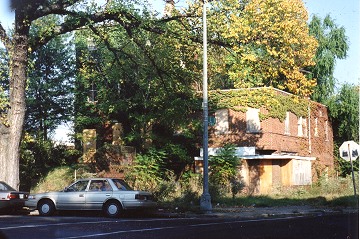 I had spent almost no time below the freeway since buying our house on the south side of Capitol Hill in 1995 (the area's reputation and lack of any amenities gave us no reason to). But in 1999 and 2000, the 3rd Street on-ramp for the freeway was being rebuilt, which forced us to drive to South Capitol Street to get on the westbound freeway. We usually crossed over on K Street to New Jersey, and often got a good laugh when we'd see a sign draped on the southeast corner of the intersection touting a new multiunit residential building "steps from the Capitol." "Dear God, who would ever pay big bucks to live down HERE?" I remember saying to Mr. JDLand on more than one occasion. (So much for vision.)
I had spent almost no time below the freeway since buying our house on the south side of Capitol Hill in 1995 (the area's reputation and lack of any amenities gave us no reason to). But in 1999 and 2000, the 3rd Street on-ramp for the freeway was being rebuilt, which forced us to drive to South Capitol Street to get on the westbound freeway. We usually crossed over on K Street to New Jersey, and often got a good laugh when we'd see a sign draped on the southeast corner of the intersection touting a new multiunit residential building "steps from the Capitol." "Dear God, who would ever pay big bucks to live down HERE?" I remember saying to Mr. JDLand on more than one occasion. (So much for vision.)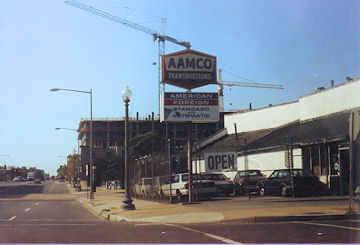 But I was still aware of the changes that were being talked about for the area, along with the first mini-building boom already underway: the construction was almost finished at the Navy Yard to house the NAVSEA operations, and we could see 80 M and 300 M rising up as we drove on the freeway, and I even remember being aware of the streetscape improvements being made to M Street (curbs, bricked medians and crosswalks). So I took a bunch of photos, and promptly forgot about them. And then started the tracking for real in early 2003, this time with a digital camera in hand.
But I was still aware of the changes that were being talked about for the area, along with the first mini-building boom already underway: the construction was almost finished at the Navy Yard to house the NAVSEA operations, and we could see 80 M and 300 M rising up as we drove on the freeway, and I even remember being aware of the streetscape improvements being made to M Street (curbs, bricked medians and crosswalks). So I took a bunch of photos, and promptly forgot about them. And then started the tracking for real in early 2003, this time with a digital camera in hand.Even though the pictures are pretty cruddy, they're still worth wandering through. Try not to look at the locations, and see if you can figure out where they are; then click on the  icon to see what's happened to these spots in the intervening decade.
icon to see what's happened to these spots in the intervening decade.
 icon to see what's happened to these spots in the intervening decade.
icon to see what's happened to these spots in the intervening decade.|
Comments (0)
More posts:
Rearview Mirror, JDLand stuff
|
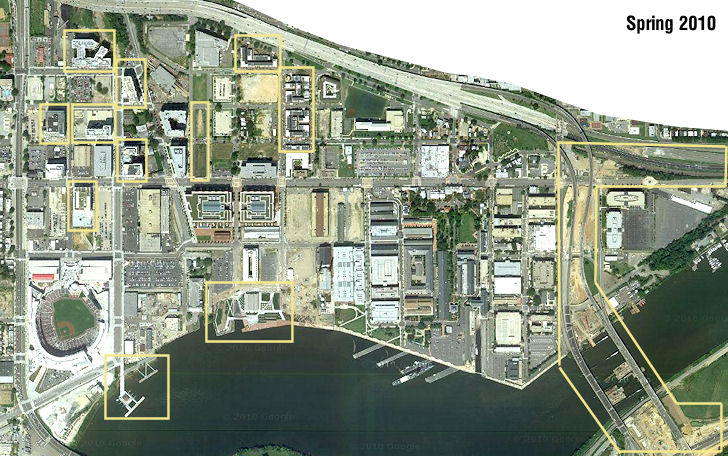 GGW sent out the alert this morning that Google has updated its satellite images of DC, giving us the first overhead images of Near Southeast since Spring 2008. I've added this (somewhat washed out) view to my Satellite Images page, where you can compare it to images from Google and other sources from 1949 (!), 1988, 2002, 2004, 2005, 2006, and 2008. (But you'll also want to visit Google Maps to be able to zoom in on the latest image to get a better view.) Considering that the 2008-10 time frame will be looked back on as the era of the Economic Downtown, there are still plenty of changes to see, including the first phase of Capitol Quarter, the Yards Park and Diamond Teague Park, the construction of the new 11th Street Bridges, and the completion of a number of office and residential buildings north of Nationals Park. (The stadium looks kind of cool from on high as well.) And the lack of schoolbuses at Canal Park!
GGW sent out the alert this morning that Google has updated its satellite images of DC, giving us the first overhead images of Near Southeast since Spring 2008. I've added this (somewhat washed out) view to my Satellite Images page, where you can compare it to images from Google and other sources from 1949 (!), 1988, 2002, 2004, 2005, 2006, and 2008. (But you'll also want to visit Google Maps to be able to zoom in on the latest image to get a better view.) Considering that the 2008-10 time frame will be looked back on as the era of the Economic Downtown, there are still plenty of changes to see, including the first phase of Capitol Quarter, the Yards Park and Diamond Teague Park, the construction of the new 11th Street Bridges, and the completion of a number of office and residential buildings north of Nationals Park. (The stadium looks kind of cool from on high as well.) And the lack of schoolbuses at Canal Park!|
Comments (0)
More posts:
Rearview Mirror, JDLand stuff
|
A few things to pass along as we kiss summer goodbye (yes, I know it technically doesn't end for another few weeks, blah blah blah):
* The Capitol Riverfront BID is applying for a DC Public Art Building Communities grant to get funding to "improve the look, feel and experience of traveling into and out of the Capitol Riverfront along New Jersey Ave., SE, while also creating unique gateway art that represents the identity, sense of place and community in the Capitol Riverfront neighborhood." They will be presenting their concepts at the Sept. 13 ANC 6D meeting, with applications being due on Oct. 13. If the project is selected to receive a grant, there would be public meetings sometime next year to "refine" the concepts, with hopes to complete the project by fall 2011. Though I can't imagine why anyone would want to beautify THIS!
* I'm not seeing this on the posted agenda yet, but a reader reports to me that CSX will be making presentations to ANC 6B's Planning and Zoning Committee tonight (Sept. 7) and the full ANC on Sept. 21 about a permit the freight company is apparently requesting to conduct an archaeological survey of Virginia Avenue Park prior to their planned expansion of the tunnel that runs under the park.
* Tonight you might see some folks with clipboards hanging around the Navy Yard Metro station entrances; they will be part of the Public Transportation Takes Us There petition drive by the American Public Transportation Association, trying to convince Congress to pass a long-term surface transportation funding bill. For the point of view of someone who has signed the petition, read this recent Richard Layman post. (I am wondering, and have no answer, whether this is the bill that CSX has been looking toward [along with other public money options] for funding the rest of the National Gateway project, which includes the expansion of the Virginia Avenue Tunnel.)
* You may have seen commenter MJM referencing recently his newfound obsession with the history of Near Southeast, and now he's put up a blog where you can share in the fruits of his research.
|
Comments (0)
More posts:
ANC News, Capitol Riverfront BID, CSX/Virginia Ave. Tunnel, meetings, New Jersey Ave., Rearview Mirror, Nationals Park, Virginia Ave Park
|
Two DDOT-related items of note to pass along: * Adding to their growing Flickr cache of historic photos, DDOT has posted 23 photos from the construction of the Southeast/Southwest Freeway. They're a bit grainy (they look like they may have gotten water-splattered at some point), but most of them are from the area along Virginia Avenue near 6th Street, SE, so you'll see the old Capper Apartment buildings at 5th and Virginia, along with the Ellen Wilson projects that were north of Virginia. When I get some spare moments, I will of course be grabbing some of these shots to add to my own Historic Photos page (thank you, Creative Commons license!). This is wonderful of DDOT to be posting photos from their archive, and I hope they keep them coming. And other DC agencies with their own photo archives should take note.
* Adding to their growing Flickr cache of historic photos, DDOT has posted 23 photos from the construction of the Southeast/Southwest Freeway. They're a bit grainy (they look like they may have gotten water-splattered at some point), but most of them are from the area along Virginia Avenue near 6th Street, SE, so you'll see the old Capper Apartment buildings at 5th and Virginia, along with the Ellen Wilson projects that were north of Virginia. When I get some spare moments, I will of course be grabbing some of these shots to add to my own Historic Photos page (thank you, Creative Commons license!). This is wonderful of DDOT to be posting photos from their archive, and I hope they keep them coming. And other DC agencies with their own photo archives should take note.
* There's been a couple changes to the route of the Union Station-Navy Yard Circulator: "Service on this line has been streamlined near Columbus Circle in front of Union Station, providing a faster trip and allowing passengers to transfer between the Georgetown route and Navy Yard route on Massachusetts Avenue.Stops have also been added on Seward Square (Pennsylvania Avenue at 5th Street SE) on Capitol Hill. Because of construction to begin this fall on Columbus Circle, the stop at Delaware Avenue had to be discontinued for passenger safety."
 * Adding to their growing Flickr cache of historic photos, DDOT has posted 23 photos from the construction of the Southeast/Southwest Freeway. They're a bit grainy (they look like they may have gotten water-splattered at some point), but most of them are from the area along Virginia Avenue near 6th Street, SE, so you'll see the old Capper Apartment buildings at 5th and Virginia, along with the Ellen Wilson projects that were north of Virginia. When I get some spare moments, I will of course be grabbing some of these shots to add to my own Historic Photos page (thank you, Creative Commons license!). This is wonderful of DDOT to be posting photos from their archive, and I hope they keep them coming. And other DC agencies with their own photo archives should take note.
* Adding to their growing Flickr cache of historic photos, DDOT has posted 23 photos from the construction of the Southeast/Southwest Freeway. They're a bit grainy (they look like they may have gotten water-splattered at some point), but most of them are from the area along Virginia Avenue near 6th Street, SE, so you'll see the old Capper Apartment buildings at 5th and Virginia, along with the Ellen Wilson projects that were north of Virginia. When I get some spare moments, I will of course be grabbing some of these shots to add to my own Historic Photos page (thank you, Creative Commons license!). This is wonderful of DDOT to be posting photos from their archive, and I hope they keep them coming. And other DC agencies with their own photo archives should take note.|
Comments (0)
More posts:
circulator, Rearview Mirror
|
(A sadly well-timed edition of my series of posts looking back on the "old" Near Southeast)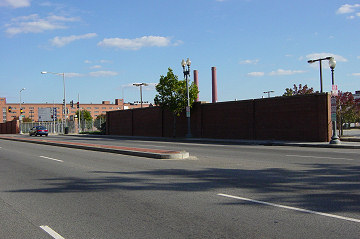 The family then went to a Metrobus stop on the south side of the 200 block of M Street, SE, standing on what was at that time a narrow sidewalk with the long red brick wall left over from the Navy Yard days behind it. Also at the bus stop were 18-year-old Charron McKethean and her six-month old daughter Charquita, who lived at 210 L St., SE, in the Cappers; they were going shopping with Charron's best friend Linda Taylor and Taylor's boyfriend Willie Callihan for an outfit for Charquita's christening the next day.
The family then went to a Metrobus stop on the south side of the 200 block of M Street, SE, standing on what was at that time a narrow sidewalk with the long red brick wall left over from the Navy Yard days behind it. Also at the bus stop were 18-year-old Charron McKethean and her six-month old daughter Charquita, who lived at 210 L St., SE, in the Cappers; they were going shopping with Charron's best friend Linda Taylor and Taylor's boyfriend Willie Callihan for an outfit for Charquita's christening the next day. Seven of group were killed: Sandra Scott and her entire family died, as well as six-month-old Charquita McKethean and Linda Taylor, who was 18 and lived in the 200 block of M Street, SW. It was believed to be the deadliest car accident in the city's history to that time, and appears to still hold that title today.
Seven of group were killed: Sandra Scott and her entire family died, as well as six-month-old Charquita McKethean and Linda Taylor, who was 18 and lived in the 200 block of M Street, SW. It was believed to be the deadliest car accident in the city's history to that time, and appears to still hold that title today.
On August 25, 1984, 24-year-old Sandra Scott of Anacostia went on a birthday visit to her mother, Maudie McBrayer, at her Capper apartment at 920 Third Street, SE. Sandra brought her husband, Theodore "Teddy" Crisp, and their three children, five-year-old Chanta, one-year-old Sophia, and six-week-old baby Tandra.
 The family then went to a Metrobus stop on the south side of the 200 block of M Street, SE, standing on what was at that time a narrow sidewalk with the long red brick wall left over from the Navy Yard days behind it. Also at the bus stop were 18-year-old Charron McKethean and her six-month old daughter Charquita, who lived at 210 L St., SE, in the Cappers; they were going shopping with Charron's best friend Linda Taylor and Taylor's boyfriend Willie Callihan for an outfit for Charquita's christening the next day.
The family then went to a Metrobus stop on the south side of the 200 block of M Street, SE, standing on what was at that time a narrow sidewalk with the long red brick wall left over from the Navy Yard days behind it. Also at the bus stop were 18-year-old Charron McKethean and her six-month old daughter Charquita, who lived at 210 L St., SE, in the Cappers; they were going shopping with Charron's best friend Linda Taylor and Taylor's boyfriend Willie Callihan for an outfit for Charquita's christening the next day.As they waited at around 6:15 pm, a Plymouth Valiant going eastbound at an estimated 70 to 80 mph in the westbound lanes struck the median, went airborne, landed in the eastbound lanes, partially hopped the curb, and struck all nine people waiting for the bus. The car then flipped, crashed, and burst into flames near Third Street.
The Washington Post described rescue personnel calling the resulting scene "one of the most gruesome they had witnessed," with some of the victims having been crushed by the car against the wall and a lamppost on the sidewalk. "I've been 21 years on this job, and I've never seen anything like it," said Fire Capt. James Thorn, saying that the driver had "just ground [the victims] right into" the lamppost and the brick wall.
 Seven of group were killed: Sandra Scott and her entire family died, as well as six-month-old Charquita McKethean and Linda Taylor, who was 18 and lived in the 200 block of M Street, SW. It was believed to be the deadliest car accident in the city's history to that time, and appears to still hold that title today.
Seven of group were killed: Sandra Scott and her entire family died, as well as six-month-old Charquita McKethean and Linda Taylor, who was 18 and lived in the 200 block of M Street, SW. It was believed to be the deadliest car accident in the city's history to that time, and appears to still hold that title today.The driver of car was 41-year-old Robert Lee Williams, whose blood alcohol level at the time of the crash was .10 and who admitted to having used heroin about 25 minutes before the crash. He had been paroled six weeks earlier after serving less than four years of a 20-year sentence for a 1980 bank robbery conviction in Alexandria, and was also on parole in the District for a 1977 armed robbery conviction. There were also convictions for housebreaking, robbery, and grand larceny on his record.
In 1985, Williams pleaded guilty to two counts of manslaughter while armed (with a car) and five counts of manslaughter, along with a count of driving while intoxicated. He was sentenced to 35 to 105 years in prison. At his sentencing, he told the courtroom that he was sorry and would give his "own life to save those kids." Charron McKethean, one of the crash's two survivors and mother of one of the youngest victims, was in the courtroom with her 2 1/2-month-old baby, and told the Post, "I couldn't look at the man that killed my daughter. The sentence was reasonable, but it is not going to bring back any of our lives."
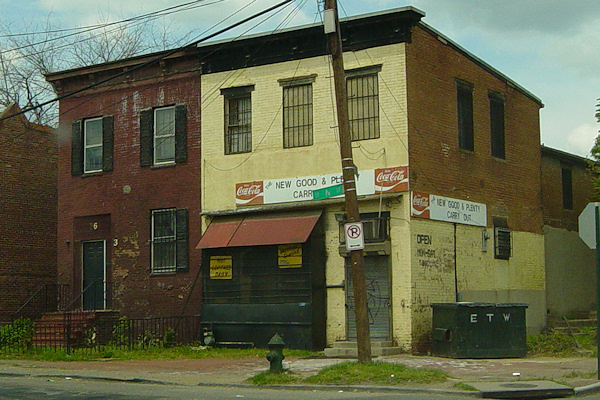 They say you never really know what's going on inside the walls of someone's home, and that certainly would have been the case if you had wandered by the northwest corner of Half and N in the early 1980s. The red brick rowhouse at 36 N Street, SE (seen at left in May 2003) would have looked unassuming enough to you, until you opened up your copy of the Washington Post on March 2, 1981, and read this:
They say you never really know what's going on inside the walls of someone's home, and that certainly would have been the case if you had wandered by the northwest corner of Half and N in the early 1980s. The red brick rowhouse at 36 N Street, SE (seen at left in May 2003) would have looked unassuming enough to you, until you opened up your copy of the Washington Post on March 2, 1981, and read this:"It was his first night at The Playground Swing Club in Southeast Washington, and the 37-year-old Army veteran was ready. He stripped and headed up the red-carpeted stairs to the lounge where a few men and women, most dressed only in robes, were sitting on cushioned floors and platforms. [...] Soon, he and a young woman he had never before met strolled into The Playroom, where bodies were lying in all directions on mattresses and a raised platform. He and the woman joined in. 'Everybody freeze!" a voice suddenly shouted. 'This is a raid!' "
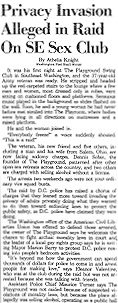 DC police had spent six weeks investigating The Playground, work which included having two undercover police couples "stripped to their underwear [who] spent three hours listening to the friendly discussions and watching the lovemaking." But when the bust happened in February of 1981, there were no charges of anyone paying for sex: the owner eventually was sentenced to 30 days in jail and fined $500 for operating a public hall without a license and failing to have a proper certificate of occupancy for the club. An additional charge of selling alcohol without a license was dropped.
DC police had spent six weeks investigating The Playground, work which included having two undercover police couples "stripped to their underwear [who] spent three hours listening to the friendly discussions and watching the lovemaking." But when the bust happened in February of 1981, there were no charges of anyone paying for sex: the owner eventually was sentenced to 30 days in jail and fined $500 for operating a public hall without a license and failing to have a proper certificate of occupancy for the club. An additional charge of selling alcohol without a license was dropped.A few of the "participants" at the house that night were charged under the city's sodomy laws, which brought swift condemnation from the ACLU: "Sexual conduct between consenting adults is none of the government's business." The raid also made for titillating reading in the Post, as the paper dryly explained the "swinging" culture: "What was happening at The Playground was a plain and simple orgy--an activity that seems to have become as common among a certain underground of adults as was dancing cheek-to-cheek in the 1930s."
The Playground was closed soon after, and a 1982 attempt to turn 36 N into an "erotica museum" was shot down by the city and neighbors. The rowhouse itself lasted until 2005, getting demolished two years before its neighbors met the wrecking ball as well. The site, now owned by Akridge as part of its Half Street footprint, is directly across from Nationals Park (which I guess you could also call a swinging establishment!), where the Bullpen now provides a different brand of entertainment during baseball season.
As for the Playground's owner? It was Dennis Sobin, longtime city activist and current mayoral candidate. A profile of Sobin earlier this year by the Georgetown Voice gives a quick summary of his years in Washington, including his ownership of multiple strip clubs, adult bookstores, and brothels in the late 70s, a third-place finish in the 1982 mayor's race, and a 10-year prison term in Florida on child pornography charges. He currently runs the Prisons Foundation, devoted to prison artists and their work.
(And no, I had no idea that this little item would end up tied to current city politics when I started!)
|
Comments (0)
More posts:
West Half St., Fairgrounds/Bullpen, Rearview Mirror
|
Readers may be familiar with the map a little ways down the right side of the JDLand home page, showing recent crimes in the neighborhood (along with a larger one showing more crime statistics for the area since 2005). However, there's another map and dataset I've wanted to build for a long time, that I'm finally launching today. It's not anything to really celebrate, however: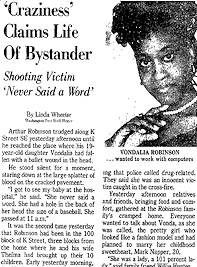 It turns me into an old codger to say it, but it's really true: those of you who didn't live in the DC area in the late 1980s and 1990s really have no concept of what Washington and its residents went through in those years. Even though large swaths of the city were considered "safe," with the bulk of the epidemic crime happening in certain neighborhoods, everyone was affected by the unrelenting drumbeat of murders and violence.
It turns me into an old codger to say it, but it's really true: those of you who didn't live in the DC area in the late 1980s and 1990s really have no concept of what Washington and its residents went through in those years. Even though large swaths of the city were considered "safe," with the bulk of the epidemic crime happening in certain neighborhoods, everyone was affected by the unrelenting drumbeat of murders and violence. 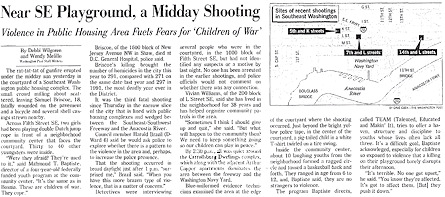
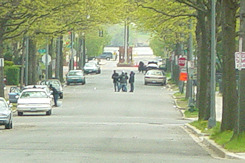 And yet the violence of the era probably fueled my interest in watching the city's redevelopment, to see neighborhoods that I had given up for lost in 1990 (such as Massachusetts Avenue east of Mt. Vernon Square) turn into luxury condo havens by the early 2000s. And it was why I began to watch--with no small sense of wonderment and even a little skepticism--as I started to hear in the late 1990s about the plans to "revitalize" the area south of the Southeast Freeway, an area that was a near-total No-Go for me from the time I moved to the south side of Capitol Hill in 1994 until my first furtive photographic forays by car in 2000 and 2003. (It's somewhat amazing now to realize that I did not actually put my feet on the ground at Third and K, SE, until the summer of 2005.)
And yet the violence of the era probably fueled my interest in watching the city's redevelopment, to see neighborhoods that I had given up for lost in 1990 (such as Massachusetts Avenue east of Mt. Vernon Square) turn into luxury condo havens by the early 2000s. And it was why I began to watch--with no small sense of wonderment and even a little skepticism--as I started to hear in the late 1990s about the plans to "revitalize" the area south of the Southeast Freeway, an area that was a near-total No-Go for me from the time I moved to the south side of Capitol Hill in 1994 until my first furtive photographic forays by car in 2000 and 2003. (It's somewhat amazing now to realize that I did not actually put my feet on the ground at Third and K, SE, until the summer of 2005.)
What you're looking at is a map of 64 violent deaths that occurred in Near Southeast between 1987 and 2004, when crack and other drugs and the accompanying violence nearly destroyed Washington, DC. And, if you go to the page itself, you will see the breakout of each death, with a name of the victim (when available), the date and location, and a brief thumbnail of what happened. The map and the data are interactive, so you can view just by year, or location, or type of death. It's not uplifting reading, but I really do recommend taking the time to go through it.
I can't pretend that this is a complete list; there are no online databases that easily offer up this data. I spent hours (and hours and hours) doing "grid searches" of the Washington Post and Washington Times electronic databases, having to search by street names and locations ("300 block of K street, SE; 300 block of L Street, SE; 3rd and K streets, SE; 1000 block of 3rd Street, SE;" etc. etc.). There's no guarantee that the newspapers mentioned every homicide, especially in the years when there were more than 400 murders across the city.
And, of course, this doesn't begin to capture the number of other crimes in the neighborhood during those years that didn't result in homicides--the robberies, the assaults, the non-fatal shootings and stabbings, etc.
It should be remembered that Near Southeast wasn't anywhere close to being the most dangerous area in the city; the 64 murders I've documented aren't even one percent of the 6,023 murders reported in this 18-year period (source: MPD, via the Internet Archive). So, as you look at this Near Southeast list, multiply it by 100 to imagine all the people who were killed in the city in those years.
 It turns me into an old codger to say it, but it's really true: those of you who didn't live in the DC area in the late 1980s and 1990s really have no concept of what Washington and its residents went through in those years. Even though large swaths of the city were considered "safe," with the bulk of the epidemic crime happening in certain neighborhoods, everyone was affected by the unrelenting drumbeat of murders and violence.
It turns me into an old codger to say it, but it's really true: those of you who didn't live in the DC area in the late 1980s and 1990s really have no concept of what Washington and its residents went through in those years. Even though large swaths of the city were considered "safe," with the bulk of the epidemic crime happening in certain neighborhoods, everyone was affected by the unrelenting drumbeat of murders and violence. Nights with seven murders in DC were unusual but not extraordinary; reading the paper each day with little more than tiny blurbs on most homicides (because they weren't really "news") made for a bleak landscape, even if you spent most of your time in sections of the city where day-to-day life seemed unaffected. DC's title of "Murder Capital of the World" was known far and wide, to the point that if you were traveling and told someone where you from, you'd often receive a sad shake of the head and hear, "It's such a shame what's happened to that lovely city."
It was a terrible time; and I say this as someone who was never affected by the violence personally in any way, other than knowing to avoid certain areas and be very careful during nights on the town. Looking back on it all now, through the lens of how far the city has come, makes the level of violence seem all the more incomprehensible and maddening. There's no question that I have become a little haunted over the past few weeks as I compiled this list, as my old generalized feelings of "quite a few people died on these streets over the years" have now been replaced with names, locations, a few photos, and gruesome details of executions and people in the wrong place at the wrong time.

 And yet the violence of the era probably fueled my interest in watching the city's redevelopment, to see neighborhoods that I had given up for lost in 1990 (such as Massachusetts Avenue east of Mt. Vernon Square) turn into luxury condo havens by the early 2000s. And it was why I began to watch--with no small sense of wonderment and even a little skepticism--as I started to hear in the late 1990s about the plans to "revitalize" the area south of the Southeast Freeway, an area that was a near-total No-Go for me from the time I moved to the south side of Capitol Hill in 1994 until my first furtive photographic forays by car in 2000 and 2003. (It's somewhat amazing now to realize that I did not actually put my feet on the ground at Third and K, SE, until the summer of 2005.)
And yet the violence of the era probably fueled my interest in watching the city's redevelopment, to see neighborhoods that I had given up for lost in 1990 (such as Massachusetts Avenue east of Mt. Vernon Square) turn into luxury condo havens by the early 2000s. And it was why I began to watch--with no small sense of wonderment and even a little skepticism--as I started to hear in the late 1990s about the plans to "revitalize" the area south of the Southeast Freeway, an area that was a near-total No-Go for me from the time I moved to the south side of Capitol Hill in 1994 until my first furtive photographic forays by car in 2000 and 2003. (It's somewhat amazing now to realize that I did not actually put my feet on the ground at Third and K, SE, until the summer of 2005.)I'll be writing in more detail in future entries about the violence in the Cappers, and at the Chapter III nightclub, but I wanted to post this overview first, to illustrate Near Southeast's descent to rock bottom for the people who might not be familiar with the recent history of the neighborhood, and also to remind everyone else of just what we as a city went through, as those memories become somewhat hazy in an era when some of the biggest battles are over funding for streetcars and dog parks. The city is certainly not without violence now, but the scale just doesn't compare.
And perhaps it'll also help clear up why I might not react with quite so much alarm when new residents write me concerned about a wave of auto thefts or other property crimes. I admit that it's somewhat unfair, but I think newcomers can talk to almost anyone who lived in Washington during the era of the Crack Wars and get the same reaction: You just have no idea.
UPDATE: Just to close the circle a bit, I should note that the reason I ended the dataset in 2004 is because, to the best of my knowledge, there have been no murders in Near Southeast since 21-year-old Terence Gathers died at Third and K on March 25 of that year.
Via the BID's latest newsletter: "Share your stories of the historic Southeast DC neighborhood as we embark on the creation of a new Neighborhood Heritage Trail in the Capitol Riverfront. Cultural Tourism DC, in partnership with the Capitol Riverfront BID, is holding two community meetings for the public to share stories, bring photos and help shape the community's heritage trail. The first meeting will be on Wednesday, June 23rd at 7 PM at Arthur Capper Senior I, 900 Fifth Street, SE." See the flyer for more information.
(This is also a good time to mention that there won't be a Sunday Rearview Mirror this weekend--I have a good one on tap for next week, though.)
|
Comments (0)
More posts:
Capitol Riverfront BID, Rearview Mirror
|



